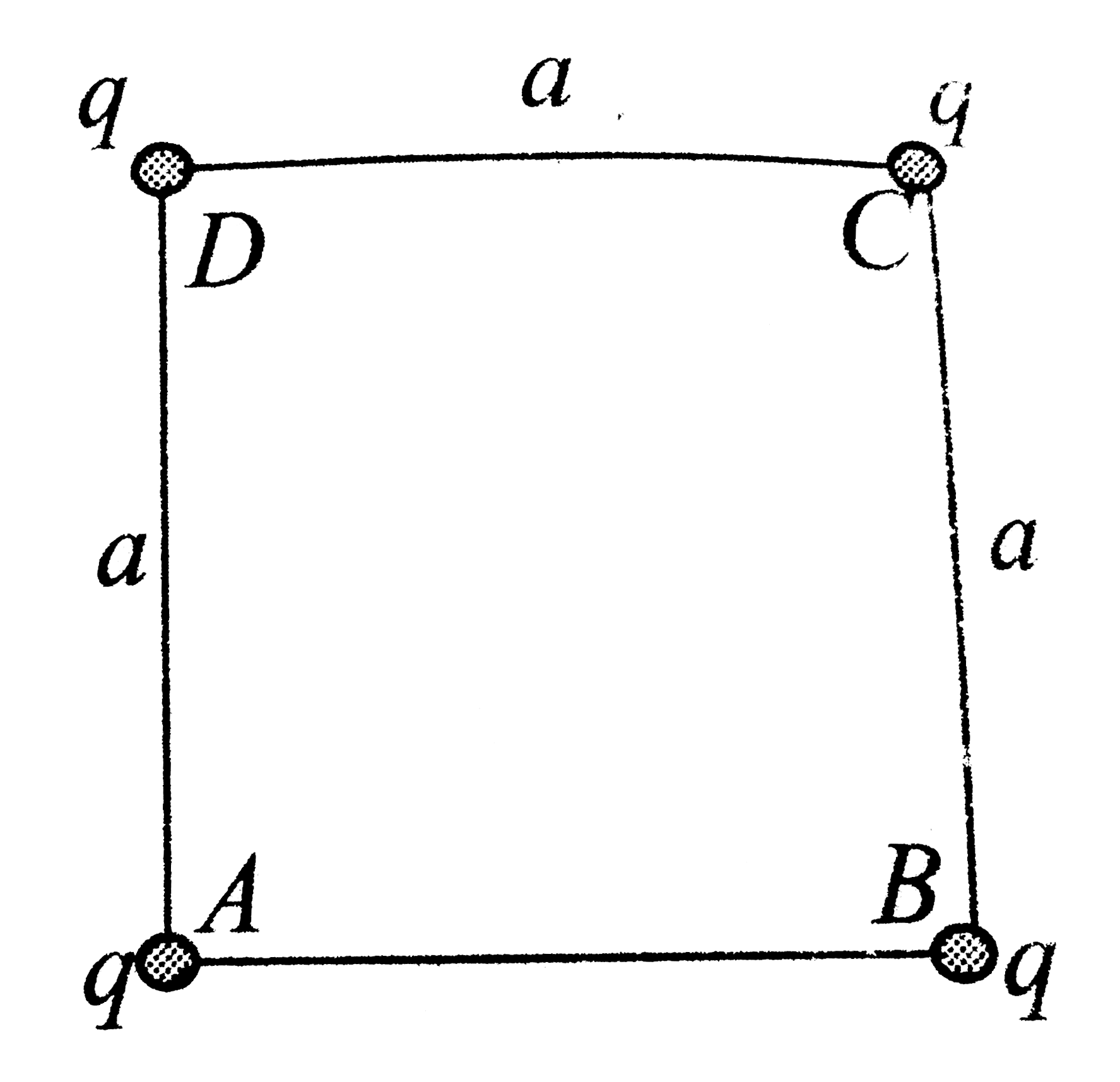Four equal charges 2.0×10−6C each are fixed at the four corners of a squae of side 5 cm. Find the coulomba force eperienced by one of the charges due to the rest three.
To find the Coulomb force experienced by one of the charges due to the other three charges in a square configuration, we can follow these steps:
Step 1: Understand the Configuration
We have four equal charges, each of 2.0×10−6C, placed at the corners of a square with a side length of 5cm (or 0.05m). We will calculate the force on one charge due to the other three charges.
Step 2: Identify the Forces
Let’s denote the charges at the corners of the square as Q1, Q2, Q3, and Q4. We will calculate the force on charge Q1 due to charges Q2, Q3, and Q4.
Step 3: Calculate the Forces Between Charges
1. Force between Q1 and Q2 (which are adjacent):
- The distance R between Q1 and Q2 is 0.05m.
- Using Coulomb's Law:
F12=kQ1Q2R2=(9×109)(2.0×10−6)2(0.05)2
- Calculate F12:
F12=9×1094.0×10−120.0025=14.4N
2. Force between Q1 and Q4 (which are also adjacent):
- This force F14 is equal to F12 since Q1 and Q4 are the same distance apart:
F14=14.4N
3. Force between Q1 and Q3 (which are diagonally opposite):
- The distance between Q1 and Q3 is:
R=√(0.05)2+(0.05)2=0.05√2m
- Calculate F13:
F13=kQ1Q3R2=(9×109)(2.0×10−6)2(0.05√2)2
- Simplifying:
F13=9×1094.0×10−120.005=7.2N
Step 4: Calculate the Resultant Force
- The forces F12 and F14 act at right angles to each other. We can find the resultant force FR from these two forces using the Pythagorean theorem:
FR=√F212+F214=√(14.4)2+(14.4)2=14.4√2≈20.3N
- Now, we need to consider the force F13 which acts diagonally. The angle between FR and F13 is 45∘.
Step 5: Calculate the Net Force
- The net force Fnet can be calculated using the cosine of the angle:
Fnet=√F2R+F213+2FRF13cos(135∘)
where 135∘ is the angle between FR and F13.
Step 6: Final Calculation
- Plugging in the values:
Fnet=√(20.3)2+(7.2)2+2⋅20.3⋅7.2⋅(−0.7071)
- Calculate the resultant force to find the final answer.
Final Answer
After performing the calculations, we find that the net force experienced by one charge due to the other three charges is approximately 27.36 N.
We have four equal charges, each of 2.0×10−6C, placed at the corners of a square with a side length of 5cm (or 0.05m). We will calculate the force on one charge due to the other three charges.
Let’s denote the charges at the corners of the square as Q1, Q2, Q3, and Q4. We will calculate the force on charge Q1 due to charges Q2, Q3, and Q4.
1. Force between Q1 and Q2 (which are adjacent):
- The distance R between Q1 and Q2 is 0.05m.
- Using Coulomb's Law:
F12=kQ1Q2R2=(9×109)(2.0×10−6)2(0.05)2
- Calculate F12:
F12=9×1094.0×10−120.0025=14.4N
- This force F14 is equal to F12 since Q1 and Q4 are the same distance apart:
F14=14.4N
- The distance between Q1 and Q3 is:
R=√(0.05)2+(0.05)2=0.05√2m
- Calculate F13:
F13=kQ1Q3R2=(9×109)(2.0×10−6)2(0.05√2)2
- Simplifying:
F13=9×1094.0×10−120.005=7.2N
- The forces F12 and F14 act at right angles to each other. We can find the resultant force FR from these two forces using the Pythagorean theorem:
FR=√F212+F214=√(14.4)2+(14.4)2=14.4√2≈20.3N
- The net force Fnet can be calculated using the cosine of the angle:
Fnet=√F2R+F213+2FRF13cos(135∘)
where 135∘ is the angle between FR and F13.
- Plugging in the values:
Fnet=√(20.3)2+(7.2)2+2⋅20.3⋅7.2⋅(−0.7071)
- Calculate the resultant force to find the final answer.
After performing the calculations, we find that the net force experienced by one charge due to the other three charges is approximately 27.36 N.
Topper's Solved these Questions
- ELECTRIC FIELD AND POTENTIALBOOK - HC VERMACHAPTER - ELECTRIC FIELD AND POTENTIALEXERCISE - Objective 2
8 Videos
- ELECTRIC CURRENT THROUGH GASESBOOK - HC VERMACHAPTER - ELECTRIC CURRENT THROUGH GASESEXERCISE - Exercises
23 Videos
- ELECTROMAGNETIC INDUCTIONBOOK - HC VERMACHAPTER - ELECTROMAGNETIC INDUCTIONEXERCISE - EXERCISE
9 Videos
Similar Questions
Three equal charges, 2.0×10−6 C each, are held fixed at the three corners of a square of side 5 cm. find the Coulomb force experienced by one of the charges due to the rest two.
View SolutionFour identical charges q are placed at the corners of a square of side a. Find the potential energy of one of the charges due to the remaining charges.
 .
.
View Solution
Knowledge Check
Charges of +103×10−9C are placed at each of the four corners of a square of side 8cm. The potential at the intersection of the diagonals is
A150√2 voltB1500√2 voltC900√2 voltD900 voltFour equal charges Q are placed at the four corners of a square of each side is 'a'. Work done in removing a charge −Q from its centre to infinity is
AzeroB√2q2π∈0aC√2qπ∈0aDq2π∈0aCharge of 5μC each are placed at the corners of an equilateral triangle of side 10 cm. Then the force on each charge is :-
A78 NB39 NC29 ND22.5 N
Four equal point harges each 16μC are placed on the four corners of a square of side 0.2 m. Calculate the force on any one of the charges.
View Solution(i) Three equak charge q0 each are placed at three corners of an equilateral triangle of side 'a'. Find out dorce acting on one of the charge due to other two charges ?
(ii) In the above question, if one of the charge is replaced by negative charge then find out force acting on it due to other charges ?
(iii) Repeat the part (i) if magnitude of each charge is doubled and side of triangle is reduced to half.
View SolutionFour identical point charges q are placed at four corners of a square of side a. Find the potential energy of the charge system.
 .
.
View SolutionFour point charges of +1μc each are placed on the four corners of a square of side 1 m. Calculate the electric potential at the centre of the square.
View SolutionFour equal charges each 16μC are placed on four corners of a square of side 0.4m. Calculate force on q is zero, how are Q and q related ?
View Solution
